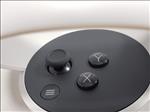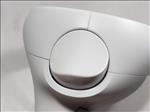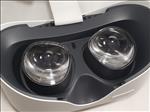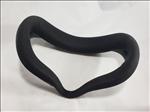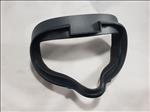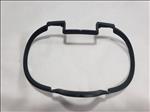
Oculus Quest 2
Back in the day, I visited CES and had a meeting with the original founders of Oculus. The headset blew me away and I quickly purchased an Oculus DK2. I was hooked. VR was the future for me. I’ve owned a bunch of them over the years, and one of the best ways to play was wirelessly on the HTC Vive with the wireless kit. Oculus has been in the forefront of VR for a while and they’re moving into a direction of producing an inexpensive but performant headset that’s portable with the ability to tether to a PC for a more robust experience.
The Oculus Quest 2 is the sequel to the Quest, which really got a lot of people into good quality VR at a low price. Coming in at a base price of $299 for the 64GB model, Facebook has really made the Quest 2 attractive to VR gamers, especially without breaking the bank. While I don’t have the first Quest to compare it to, I’m going to be looking at it from a person who’s got a lot of experience in PC VR gaming and how well it holds up to the more traditional headsets.
Powered by the Qualcomm Snapdragon XR2, the Quest 2 is a portable VR setup that uses inside out tracking done by four cameras on the edges of the HMD. The Snapdragon processor allows for portable usage so you aren’t tethered to a PC for gaming or entertainment. It won’t give you top tier graphics, but it still delivers some great quality experiences with the processing power inside the HMD.

The one Facebook sent me has 64GB of storage space, but there is one with 256GB available for $100 more. So if you’re planning on storing a bunch of games and media, that might be the one to pick up for you.
A change from the original Quest is that the display panel is now LCD rather than OLED. I’ve been a big fan of OLED panels for VR hardware because of the deeper blacks. Of the four I own, two are OLEDs and two are LCDs and each has their pros and cons with my preference going to OLEDs. I also use a specific headset for specific types of games, but the switch to LCD from OLED is a small disappointment for me. Then again, it seems every headset these days are using LCD over OLED so that’s currently the industry standard.
Oculus though has put in a single LCD panel that’s resolution is only second to the HP Reverb 2 and Pimax 5K. We’re talking 1832x1920 per eye. To compare with the Valve Index, it has a resolution of 1440x1600 per eye while the HP Reverb 2 is 2160x2160 per eye. So that puts the Oculus Quest 2 squarely in the top tier of resolutions. With the increase in resolution, we can expect a sharper picture with the Quest 2. For those who have the original Quest, it’s roughly a 50% improvement.

A great addition is that the Quest 2 can run at 90Hz, which wasn’t available on launch but is now with an update. The previous Quest topped out at 72Hz, which for me is too slow. Yes, I’m a refresh rate snob being used to the Index’s 120Hz refresh rate, but I’ve always felt 90Hz was the minimum for a really good, smooth experience. So, it’s good to see Oculus deliver a 90Hz refresh rate with a recent update. Especially tethered, I want as fast of a refresh rate as possible when playing high quality VR games from my PC.
To get the clearest picture possible, you’ll need to adjust the spacing of the lenses to match your eye. One other headsets, you can adjust the spacing with a dial to give you a fine grain control on how far apart the lenses are. Unfortunately, the Quest 2 only has 3 spacing settings for IPD adjustment: 58mm, 63mm, and 68mm. That’s one of the downsides of having a single panel for an HMD in that it’s harder to get a finer control on lens spacing. For those with an IPD that doesn’t fit into the range of the Quest 2, you’re out of luck in getting the clearest picture possible.
The sweet spot in the Oculus Quest 2 was a little harder for me to get right, partly due to the default headstrap. With halo designs or rigid straps like in the Valve Index, HTC Vive with the Deluxe Audio Strap upgrade, or the HTC Vive Cosmos, I can lock in the position for getting the best picture quality possible with little effort in making it stay there. It took me more time to get dialed in on the Quest 2 and I felt that the strap didn’t help as much in keeping it there without having pressure on my face that sometimes became a little uncomfortable in longer sessions.

You can adjust the strap’s orientation vertically a tad as the arms do rotate up and down, but that will also change how close or far away the speakers built into the arms sit from your ears, which can alter the sound coming from the headset. If you use your own personal headphones with the Quest 2, this is a non factor and I recommend doing that versus the built-in speakers. They’re fine and I do use them at times, but they lack the bass and punch that headphones can deliver.
That said, there was an option to purchase a more rigid strap replacement from Oculus, but it seems there were quality control issues and, for now, it’s been taken off the market. Hopefully, Oculus can fix this soon. I’d love to get a replacement for the strap and make it more like my other headsets with a rigid option.
On the headset is a USB-C connector for charging an Oculus Link, a single 3.5mm headphone jack, a power button, and a volume control rocker switch. There’s also two small holes for the mic that help with noise reduction when speaking. The volume rocker located on the underside of the headset is easy to reach and a nice quick way to adjust the volume.

Let’s talk about the controllers. Each controller is powered by a single AA battery and features a halo-like design that’s similar to their past Oculus controllers. There’s an A and B button on top (X and Y on the left controller) along with a clickable thumbstick and a function button. Along with that is a trigger button and a grip button.
Comfort wise, they are alright. I didn’t have any issues with my hand size in holding it and feeling comfortable with them. I do miss the ability to just let go of the controller like I do with the Valve Index controllers, but that’s just me and my long play times with the Valve system. Overall, I find the buttons to be responsive and they have good physical feedback from pressing along with solid-feeling springs in the grip and trigger.
Something I did find surprising is that there seems to be some tracking of the thumb in space. It’s similar to the finger tracking on the Valve Index controllers and I really like that there’s an option for developers to add functionality not just by pressing the buttons, but by finger placement as well.

Putting on the headset, I found the most reliable way to do it is place the HMD on my face and then move the straps up and over my head and down the back, tightening the back when it’s in place. The Quest 2 weighs 503 grams, a 12% reduction over the Quest 1. It’s one of the lighter headsets out there, but I felt that it was too front heavy. It really needs something in the back to provide a counterweight and to alleviate the pressure on the face, which I’m sure the Elite Strap does. I’ve actually seen one person suggest taping a rock to the back of the strap to make it more comfortable. It’s not bad and I’ve seen people play for long periods of time with the default head strap, but I would like to not have to feel it at all on my face. I’ll be looking for solutions in making it more balanced, such as a FrankenQuest mod, or the Elite Strap which just went on sale again after being temporarily taken off the market for quality issues.
The facial gasket has an OK amount of foam that I feel could’ve used a little bit more for increased comfortability. It is really easy to take off. For people like me who have glasses, Oculus has included a gasket extender to move it out a little more to provide more room for glasses to sit inside the HMD without touching the lenses. I would recommend snap-in prescription lenses that you can find in such places like VR Optician to really make it simple to use and to protect the lenses inside the Quest 2 from being scratched.
At the nose area, there is a good amount of light leakage, which I know some people don’t enjoy. Some people do use it to peek out under the HMD to maybe grab a drink or just check a few things. Me, I’d rather be fully immersed in the HMD, so I’ve got some solutions on order to maybe help cover that area up entirely.

Setup is pretty darn simple and, yes, you need a Facebook account. That’s going to turn off some people and understandably so. I stopped visiting Facebook regularly a long time ago, but kept an active account for some single sign-on sites. If you don’t have a Facebook account in good standing, don’t get this headset as you won’t be able to use the Quest 2. If you don’t want a Facebook account, again don’t pick up the Quest 2. If something ever happens to your Facebook account where you’re banned or locked out, you’re not going to be able to use the Quest 2. Which is unfortunate that it’s tied that way. But for now, that’s just how it works. So, if Facebook being a requirement is a deal breaker for you, you’ll have to look elsewhere.
Once you boot up and install any updates, you’re greeted with creating a guardian play area. Whether you’re in a stationary position or doing room scale, the guardian system helps protect you from extending beyond your designated area and maybe accidentally causing damage when you use the Quest 2. A large grid will pop up into view when you’re near an edge and it’s a very nice visual indicator when you’re near your boundary.
I do really like the simplicity of the guardian setup versus other headset methods. You see a pass through of the environment in your headset and you draw with your controller the boundary you want in the room. That’s it. It’s such a simple process that I wish other headsets would adopt it. I’m looking at you, Valve and HTC.

Speaking of simplicity, the inside out tracking of the Quest 2 means you don’t have to set up any external sensors making this portable HMD truly easy to get going. While yes, setting up those sensors or lighthouses is usually a one time deal, with the Quest 2’s design you can just move to wherever you want to play and do a quick guardian setup and you’re off. I definitely love using inside out tracking for my sim setup where I can just sit down in my cockpit, put on a headset, and fire up a flight sim or racing game.
Now when I finally got into the home screen, I was amazed at how clear the picture quality was. Once I got dialed in, the clarity was truly outstanding. The colors were great and while the blacks weren’t as good, I say the levels were adequate. That’s again the downside of LCDs.
But man, was it truly a sight to behold to see how clear the picture was. If you concentrate hard enough, you can maybe, just maybe see a slight screen door effect still there. But I had to really concentrate to even see a slight gray glimmer of a screen door effect. At the resolution and pixel arrangement of the LCD, Oculus has truly achieved a feat of a smooth picture.

The god rays present in the fresnel lenses are still there, but they aren’t overly annoying. I can dismiss it in most scenes except for the very high contrast ones and with me being used to the god rays in the Index. I wasn’t too annoyed with the ones on the Quest 2.
The field of vision is the same as the Quest 1 at around 90 degrees. It’s less than the Valve’s 110, which for me, is more noticeable since I spend most of my time in the Index. I do feel like I’m looking through goggles more with the Quest 2. It’s something I do want to see headsets address in the future as field of view, in my opinion, is the one aspect of VR that needs the biggest improvement in terms of visuals now that we have very good LCD screens for clarity.
Tracking seems really good for an inside out system like the Quest 2. The four cameras provide a nice large volume of tracking having used inside out tracking systems of the Cosmos, Samsung Odyssey+, and the Quest 2, I would say the Quest 2 is at the top of the list. Yes, there are still some blind spots and you definitely can’t use it behind you like you can in outside in systems like the lighthouses of the Valve Index, but I never felt I lost control and I rarely saw my controllers fly off like I did sometimes with the Windows Mixed Reality headset or often times with the HTC Vive Cosmos. You still need some good light conditions for this to work smoothly, but it seems the Quest 2 is pretty robust in providing accurate tracking in various light conditions.

An awesome experimental feature is the ability for the Quest 2 to track your hands. That’s right, you can just drop the controllers to use your hands to navigate through the menus. Pinch to press a button. Pinch and drag to scroll through menus. When I used the Quest 2 to just watch a video through YouTube or a video player, I completely bypassed using the controller to navigate through the menus and just used my hands like in Minority Report. I can’t wait to see games and other applications take advantage of hand tracking as the Quest 2’s implementation seems really, really well done even at this stage.
The games that you can play won’t be as high quality as you would find on the PC just because it doesn’t have the hardware to handle it like a full fledged computer, but the Snapdragon XR2 does do a good job with the horsepower it does have. Games like Beat Saber, Vader Immortal, and The Walking Dead: Saints and Sinners are great examples of great experiences using the internal hardware.
One of the things I was really interested in the Quest 2 was could it replace my other wired headsets for PC gaming. Oculus allows you to connect the Quest and Quest 2 to your PC via a USB-C cable to mimic traditional PC headsets where the PC powers the game and it’s sent to the HMD. But there’s also a piece of software that will let you do this wirelessly, which is one of the holy grails of VR gaming with high end PCs. I have the Wireless Adapter for the HTC Vive and it was really hard going back to a wired experience with the Index, so I had high hopes with the Quest 2 in replicating that experience.

Let’s start with the wired option. Oculus sells a 16ft long USB-C cable for $80 to let you tether to a PC, but has allowed for a wide variety of USB-C cables to be used instead of locking you into their solution. I picked up a 16ft USB-C cable from Amazon for $28 in order to test the viability of tethering to a PC. Plugging in the Quest 2 to my PC, I did some quick setup on both the HMD and the computer and I was able to then use features like virtual desktop and launching SteamVR games.
Getting SteamVR to show up in the menu is a little cumbersome right now. In fact, I followed some instructions I found on YouTube and I still don’t have the games showing up in the Oculus Link Home menu. It’s one of the few things about the Quest 2 that didn’t work easily. I’ve been trying to troubleshoot that part.
But when you are able to fire up a game and set the Quest 2 to 90Hz, games play quite well with no jitter or lag. That’s one of the benefits of being wired in that there’s no wireless variances to affect your gameplay. It’s buttery smooth and I was surprised to see some games even show you a virtual Quest 2 controller to let you know what the buttons are mapped to.

There is some compression going on before it sends the data over the USB-C cable to your headset. When I did the test, it said there was about 2.4 Gbps bandwidth available. Compared to DisplayPort which most HMD’s use, it’s not nearly in the range as that has 32.4 Gbps. So there’s going to have to be some compression that needs to happen in order to send the image to your headset. The good news is that I thought the image quality was still very good. It’s not as clear as a traditional HMD using DisplayPort, but by George it’s good enough to be very enjoyable. In fact, I bet you wouldn’t notice if you didn’t have another one to compare it to, but since I spend most of my time in the Index, I can see the difference myself.
For those like me who have a Surface Book 2, yes you can use the Oculus Link on the portable with a few little adjustments. The video here shows you how to get it working. After everything settled down on the first boot, I was having a pretty smooth experience on games that run well on the Surface Book 2. I would say if the game runs reasonably well using a Windows Mixed Reality headset on the Surface Book 2, it should do the same with the Oculus Link and Quest 2. Here’s the video showing how to get it done, as you need the latest Oculus software at the time of this writing and hopefully, Oculus can make it a little more user friendly in the future.
The other option which kind of blew me away was buying an application called Virtual Desktop. I’ve actually used Virtual Desktop on my PC and it’s a great piece of software. The developer of Virtual Desktop has a patch, which you have to sideload onto your Quest 2 to allow for wirelessly streaming SteamVR games to the Quest 2. That’s crazy! It couldn’t work that well could it?

Let me preface by saying the Quest 2 has built in support for WiFi 6. While I only have Wifi 5 available in my house, the ability for the Quest 2 to take advantage of the next generation of wireless speeds is a great feature.
So picking up Virtual Desktop and sideloading the patch, I decided to try out various SteamVR games streaming through a 5GHz wireless connection to the Quest 2. My PC was connected to my network with an Ethernet cable so the only wireless connection was the Quest 2. My PC is situated in the basement and I did the test in the same room as the wireless router and it housed an Intel i7-9700k with a NVIDIA GeForce RTX 3080 video card.
Oh. My. Word. It worked beautifully. I played Arizona Sunshine, Creed Rise to Glory, Pavlov, and BoxVR streaming from my PC to the Quest 2 and it worked really, really well. There are small jitters here and there but, for the most part, you can ditch your wire and go this route. Your mileage will vary depending on your setup, but I’ve read a lot of people having great success this way. One of the things I did miss when moving to the Index was the Wireless Adapter that I had with the HTC Vive, but here we are with the Oculus Quest 2 and Virtual Desktop providing a very similar experience in a much more elegant way.

And this works with my Surface Book 2 as well, so, while I loved to tether it to the laptop for better latency, I am able to do VR with that computer this way wirelessly.
So, is the Oculus Quest 2 a good VR HMD? Yes, it definitely is. For the price, it’s hard to beat the features and portability. You get a very nice clear screen with great inside out tracking and the ability to connect to your gaming PC for higher quality experiences. Controller tracking is also solid with its four-camera system. I don’t like the default strap though, so you’re looking to spend some extra money to make it more comfortable. The Facebook requirement also can have its drawbacks. The 2.5 hour battery life is a little on the short side for me, but you can connect it to an external battery via the USB-C port while playing. Speaking of battery life, each controller looks like it lasts forever on a single AA battery. While I had to recharge my headset a few times, I’m still on my first set of AA batteries and this is after a three weeks of moderate usage. That’s pretty solid engineering considering I have to switch out batteries on the Samsung Odyssey+ controller a lot more frequently.
I was really surprised at how much I did enjoy using it. Having used the GearVR many times at home, it’s definitely a huge leap over that. Oculus has really provided a high quality price of VR hardware here with a lot of upside, as well as the ability to be a good option for a main VR choice for PC gamers.

Rating: 9 Class Leading
* The product in this article was sent to us by the developer/company.

About Author
I've been reviewing products since 1997 and started out at Gaming Nexus. As one of the original writers, I was tapped to do action games and hardware. Nowadays, I work with a great group of folks on here to bring to you news and reviews on all things PC and consoles.
As for what I enjoy, I love action and survival games. I'm more of a PC gamer now than I used to be, but still enjoy the occasional console fair. Lately, I've been really playing a ton of retro games after building an arcade cabinet for myself and the kids. There's some old games I love to revisit and the cabinet really does a great job at bringing back that nostalgic feeling of going to the arcade.
View Profile



